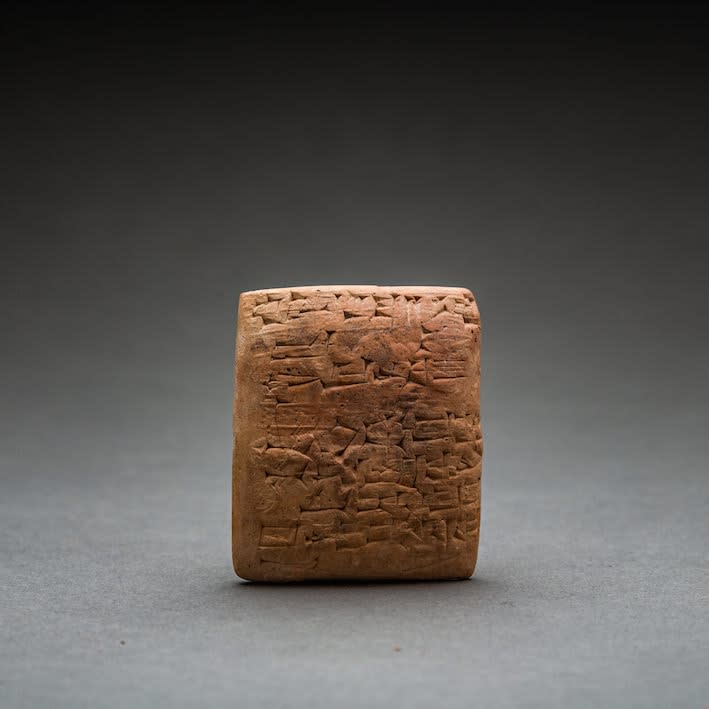Sumerian Cuneiform Tablet, 2029 BCE
4.8 x 5.6 cm
1 7/8 x 2 1/4 in
1 7/8 x 2 1/4 in
AM.0200
Sumerian cuneiform is one of the earliest known forms of written expression. First appearing in the 4th millennium BC in what is now Iraq, it was dubbed cuneiform (‘wedge-shaped’) because...
Sumerian cuneiform is one of the earliest known forms of written expression. First appearing in the 4th millennium BC in what is now Iraq, it was dubbed cuneiform (‘wedge-shaped’) because of the distinctive wedge form of the letters, created by pressing a reed stylus into wet clay. Early Sumerian writings were essentially pictograms, which became simplified in the early and mid 3rd millennium BC to a series of strokes, along with a commensurate reduction in the number of discrete signs used (from c.1500 to 600). The script system had a very long life and was used by the Sumerians as well as numerous later groups – notably the Assyrians, Elamites, Akkadians and Hittites – for around three thousand years. Certain signs and phonetic standards live on in modern languages of the Middle and Far East, but the writing system is essentially extinct. It was therefore cause for great excitement when the ‘code’ of ancient cuneiform was cracked by a group of English, French and German Assyriologists and philologists in the mid 19th century AD. This opened up a vital source of information about these ancient groups that could not have been obtained in any other way.
Cuneiform was used on monuments dedicated to heroic – and usually royal – individuals, but perhaps its most important function was that of record keeping. The palace-based society at Ur and other large urban centres was accompanied by a remarkably complex and multifaceted bureaucracy, which was run by professional administrators and a priestly class, all of whom were answerable to central court control. Most of what we know about the way the culture was run and administered comes from cuneiform tablets, which record the everyday running of the temple and palace complexes in minute detail, as in the present case. The Barakat Gallery has secured the services of Professor Lambert (University of Birmingham), a renowned expert in the decipherment and translation of cuneiform, to examine and process the information on these tablets. The following is a transcription of his analysis of this tablet:
‘An administrative document from the Third Dynasty of Ur, dated to the 9th year of Shu-Sin, fourth king of the dynasty, c. 2029 B.C. It lists items apparently for the repairs to a temple door.
Translation:
18 skins of ‘white’ sheep. 3 minas of paint. 45 bundles of reeds. 45 metal smiths for 1 day, the day of the door of the temple of Nin-isina. Document of Asibagarra, the……
Via Ur-Baba. Disbursement of the month Kirsi-ak. Year: Shu-Sin, king of Ur, built the temple of Shara in Umma.
The seal inscription of the scribe, on his cylinder seal, was rolled over the whole surface of the tablet and it can be read (with difficulty):
Ur-Baba,
Scribe,
Son of Lu-Ababa.
This is not a common type of document showing the care and attention given to temples at this time. One might have thought 45 smiths excessive for any kind of door, but only the best was enough for the gods at this time. However, it is possible that the scribe by error wrote ‘45’ from the previous line instead of a smaller number. Errors of that kind are possible, but quite rare. Curiously the official responsible for forwarding the tablet to the relevant archive wrote and sealed the tablet, not the man (Asibagarra) who is claimed as author of the tablet.’
Cuneiform was used on monuments dedicated to heroic – and usually royal – individuals, but perhaps its most important function was that of record keeping. The palace-based society at Ur and other large urban centres was accompanied by a remarkably complex and multifaceted bureaucracy, which was run by professional administrators and a priestly class, all of whom were answerable to central court control. Most of what we know about the way the culture was run and administered comes from cuneiform tablets, which record the everyday running of the temple and palace complexes in minute detail, as in the present case. The Barakat Gallery has secured the services of Professor Lambert (University of Birmingham), a renowned expert in the decipherment and translation of cuneiform, to examine and process the information on these tablets. The following is a transcription of his analysis of this tablet:
‘An administrative document from the Third Dynasty of Ur, dated to the 9th year of Shu-Sin, fourth king of the dynasty, c. 2029 B.C. It lists items apparently for the repairs to a temple door.
Translation:
18 skins of ‘white’ sheep. 3 minas of paint. 45 bundles of reeds. 45 metal smiths for 1 day, the day of the door of the temple of Nin-isina. Document of Asibagarra, the……
Via Ur-Baba. Disbursement of the month Kirsi-ak. Year: Shu-Sin, king of Ur, built the temple of Shara in Umma.
The seal inscription of the scribe, on his cylinder seal, was rolled over the whole surface of the tablet and it can be read (with difficulty):
Ur-Baba,
Scribe,
Son of Lu-Ababa.
This is not a common type of document showing the care and attention given to temples at this time. One might have thought 45 smiths excessive for any kind of door, but only the best was enough for the gods at this time. However, it is possible that the scribe by error wrote ‘45’ from the previous line instead of a smaller number. Errors of that kind are possible, but quite rare. Curiously the official responsible for forwarding the tablet to the relevant archive wrote and sealed the tablet, not the man (Asibagarra) who is claimed as author of the tablet.’
